Cross Cultural theories 跨文化理论
- 格式:ppt
- 大小:256.00 KB
- 文档页数:39
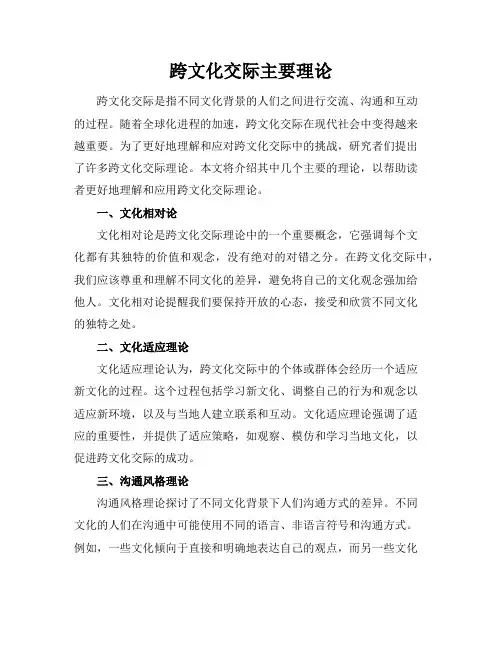
跨文化交际主要理论跨文化交际是指不同文化背景的人们之间进行交流、沟通和互动的过程。
随着全球化进程的加速,跨文化交际在现代社会中变得越来越重要。
为了更好地理解和应对跨文化交际中的挑战,研究者们提出了许多跨文化交际理论。
本文将介绍其中几个主要的理论,以帮助读者更好地理解和应用跨文化交际理论。
一、文化相对论文化相对论是跨文化交际理论中的一个重要概念,它强调每个文化都有其独特的价值和观念,没有绝对的对错之分。
在跨文化交际中,我们应该尊重和理解不同文化的差异,避免将自己的文化观念强加给他人。
文化相对论提醒我们要保持开放的心态,接受和欣赏不同文化的独特之处。
二、文化适应理论文化适应理论认为,跨文化交际中的个体或群体会经历一个适应新文化的过程。
这个过程包括学习新文化、调整自己的行为和观念以适应新环境,以及与当地人建立联系和互动。
文化适应理论强调了适应的重要性,并提供了适应策略,如观察、模仿和学习当地文化,以促进跨文化交际的成功。
三、沟通风格理论沟通风格理论探讨了不同文化背景下人们沟通方式的差异。
不同文化的人们在沟通中可能使用不同的语言、非语言符号和沟通方式。
例如,一些文化倾向于直接和明确地表达自己的观点,而另一些文化则更注重委婉和含蓄的表达。
了解不同文化的沟通风格,有助于我们更好地理解对方的意思,避免误解和冲突。
四、文化智力理论文化智力理论认为,跨文化交际中的成功取决于个体的文化智力水平。
文化智力是指个体对文化差异的意识和理解,以及在不同文化环境中有效沟通和适应的能力。
文化智力包括认知智力、情感智力和行为智力三个方面。
通过培养和提高自己的文化智力,我们可以更好地理解和应对跨文化交际中的挑战。
五、文化冲突理论文化冲突理论探讨了跨文化交际中可能出现的冲突和摩擦。
不同文化的人们在价值观、信仰、行为习惯等方面可能存在差异,这可能导致误解、偏见和冲突。
文化冲突理论提出了冲突解决策略,如建立共同目标、寻求共识、尊重差异和建立信任等,以促进跨文化交际的和谐与成功。
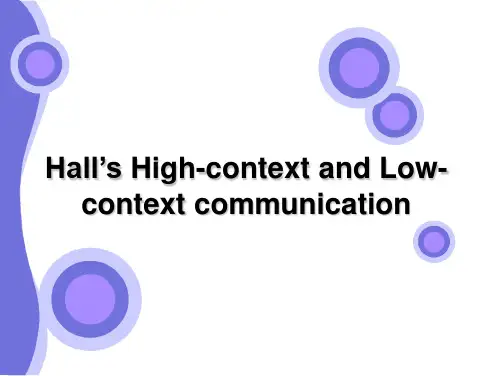
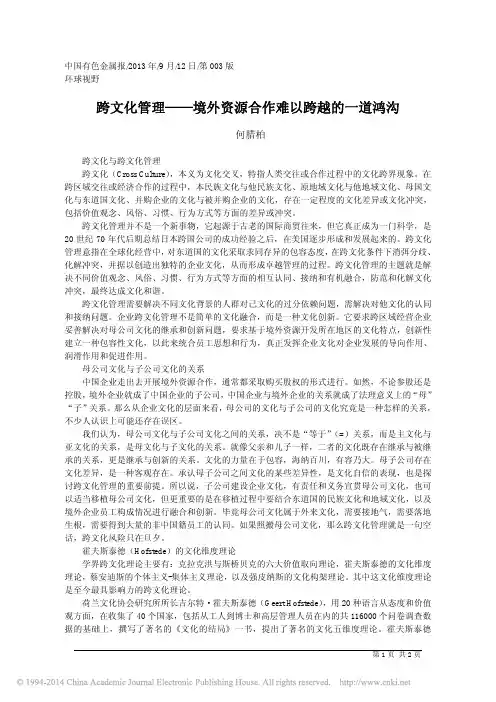
中国有色金属报/2013年/9月/12日/第003版环球视野跨文化管理——境外资源合作难以跨越的一道鸿沟何腊柏跨文化与跨文化管理跨文化(Cross Culture),本义为文化交叉,特指人类交往或合作过程中的文化跨界现象。
在跨区域交往或经济合作的过程中,本民族文化与他民族文化、原地域文化与他地域文化、母国文化与东道国文化、并购企业的文化与被并购企业的文化,存在一定程度的文化差异或文化冲突,包括价值观念、风俗、习惯、行为方式等方面的差异或冲突。
跨文化管理并不是一个新事物,它起源于古老的国际商贸往来,但它真正成为一门科学,是20世纪70年代后期总结日本跨国公司的成功经验之后,在美国逐步形成和发展起来的。
跨文化管理意指在全球化经营中,对东道国的文化采取求同存异的包容态度,在跨文化条件下消弭分歧、化解冲突,并据以创造出独特的企业文化,从而形成卓越管理的过程。
跨文化管理的主题就是解决不同价值观念、风俗、习惯、行为方式等方面的相互认同、接纳和有机融合,防范和化解文化冲突,最终达成文化和谐。
跨文化管理需要解决不同文化背景的人群对己文化的过分依赖问题,需解决对他文化的认同和接纳问题。
企业跨文化管理不是简单的文化融合,而是一种文化创新。
它要求跨区域经营企业妥善解决对母公司文化的继承和创新问题,要求基于境外资源开发所在地区的文化特点,创新性建立一种包容性文化,以此来统合员工思想和行为,真正发挥企业文化对企业发展的导向作用、润滑作用和促进作用。
母公司文化与子公司文化的关系中国企业走出去开展境外资源合作,通常都采取购买股权的形式进行。
如然,不论参股还是控股,境外企业就成了中国企业的子公司,中国企业与境外企业的关系就成了法理意义上的“母”“子”关系。
那么从企业文化的层面来看,母公司的文化与子公司的文化究竟是一种怎样的关系,不少人认识上可能还存在误区。
我们认为,母公司文化与子公司文化之间的关系,决不是“等于”(=)关系,而是主文化与亚文化的关系,是母文化与子文化的关系。
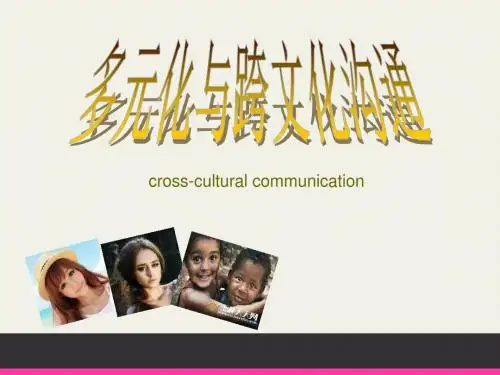
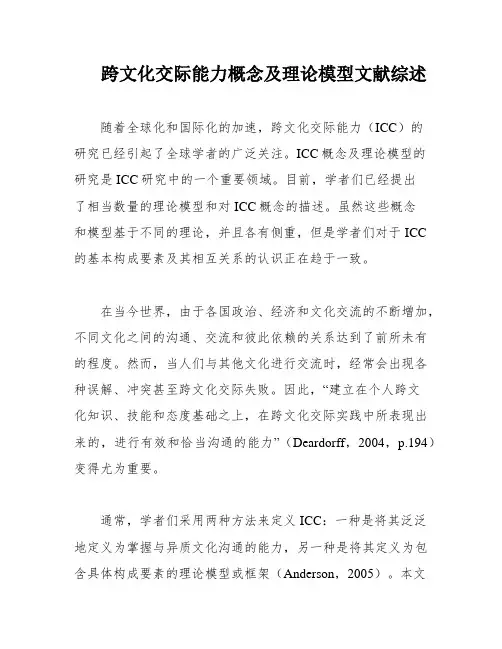
跨文化交际能力概念及理论模型文献综述随着全球化和国际化的加速,跨文化交际能力(ICC)的研究已经引起了全球学者的广泛关注。
ICC概念及理论模型的研究是ICC研究中的一个重要领域。
目前,学者们已经提出了相当数量的理论模型和对ICC概念的描述。
虽然这些概念和模型基于不同的理论,并且各有侧重,但是学者们对于ICC 的基本构成要素及其相互关系的认识正在趋于一致。
在当今世界,由于各国政治、经济和文化交流的不断增加,不同文化之间的沟通、交流和彼此依赖的关系达到了前所未有的程度。
然而,当人们与其他文化进行交流时,经常会出现各种误解、冲突甚至跨文化交际失败。
因此,“建立在个人跨文化知识、技能和态度基础之上,在跨文化交际实践中所表现出来的,进行有效和恰当沟通的能力”(Deardorff,2004,p.194)变得尤为重要。
通常,学者们采用两种方法来定义ICC:一种是将其泛泛地定义为掌握与异质文化沟通的能力,另一种是将其定义为包含具体构成要素的理论模型或框架(Anderson,2005)。
本文将对这两种定义ICC的研究成果进行梳理和评价,以期为进一步的ICC研究奠定坚实的理论基础,为后续的ICC研究指明方向。
在英语中,涉及“跨文化交际能力”的术语数量相当多。
其中,最广泛使用并为多数学者所接受的术语有:intercultural competence,XXX和XXX。
此外,根据Fantini(2006)的研究,还有其他二十种措辞方式也常被用来指代ICC,这里不再一一列举。
XXX ICC。
Firstly。
XXX different countries。
thus leading to the n of different XXX。
scholars from different countries have chosen different ways to express the same or similar concepts of ICC based on their research fields。
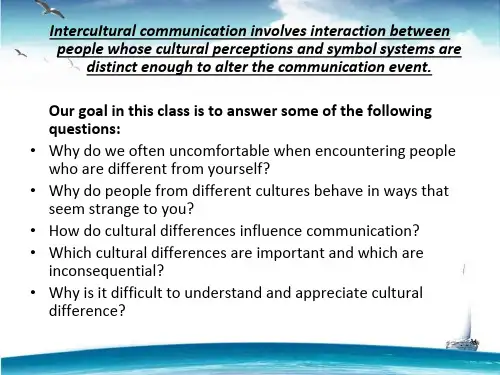
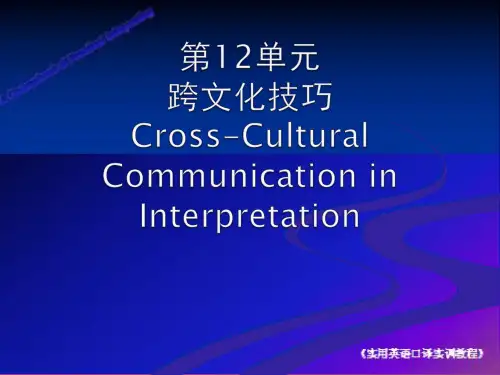
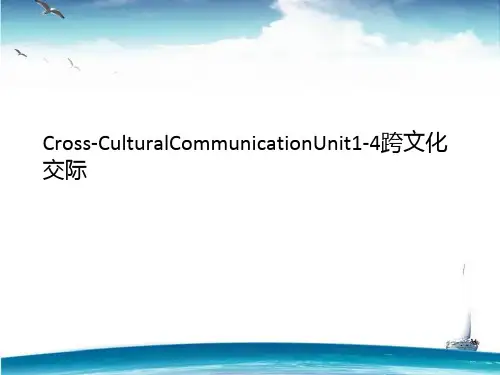
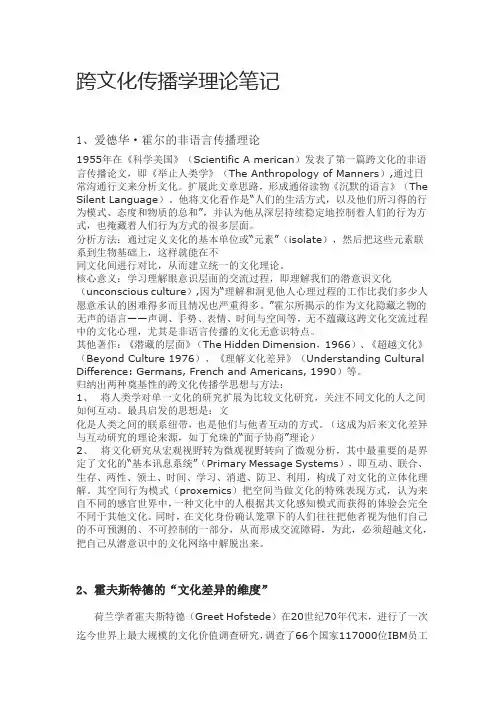
跨文化传播学理论笔记1、爱德华·霍尔的非语言传播理论1955年在《科学美国》(Scientific A merican)发表了第一篇跨文化的非语言传播论文,即《举止人类学》(The Anthropology of Manners),通过日常沟通行文来分析文化。
扩展此文章思路,形成通俗读物《沉默的语言》(The Silent Language)。
他将文化看作是“人们的生活方式,以及他们所习得的行为模式、态度和物质的总和”,并认为他从深层持续稳定地控制着人们的行为方式,也掩藏着人们行为方式的很多层面。
分析方法:通过定义文化的基本单位或“元素”(isolate),然后把这些元素联系到生物基础上,这样就能在不同文化间进行对比,从而建立统一的文化理论。
核心意义:学习理解眼意识层面的交流过程,即理解我们的潜意识文化(unconscious culture),因为“理解和洞见他人心理过程的工作比我们多少人愿意承认的困难得多而且情况也严重得多。
”霍尔所揭示的作为文化隐藏之物的无声的语言——声调、手势、表情、时间与空间等,无不蕴藏这跨文化交流过程中的文化心理,尤其是非语言传播的文化无意识特点。
其他著作:《潜藏的层面》(The Hidden Dimension,1966)、《超越文化》(Beyond Culture 1976)、《理解文化差异》(Understanding Cultural Difference: Germans, French and Americans, 1990)等。
归纳出两种奠基性的跨文化传播学思想与方法:1、将人类学对单一文化的研究扩展为比较文化研究,关注不同文化的人之间如何互动。
最具启发的思想是:文化是人类之间的联系纽带,也是他们与他者互动的方式。
(这成为后来文化差异与互动研究的理论来源,如丁允珠的“面子协商”理论)2、将文化研究从宏观视野转为微观视野转向了微观分析,其中最重要的是界定了文化的“基本讯息系统”(Primary Message Systems),即互动、联合、生存、两性、领土、时间、学习、消遣、防卫、利用,构成了对文化的立体化理解。

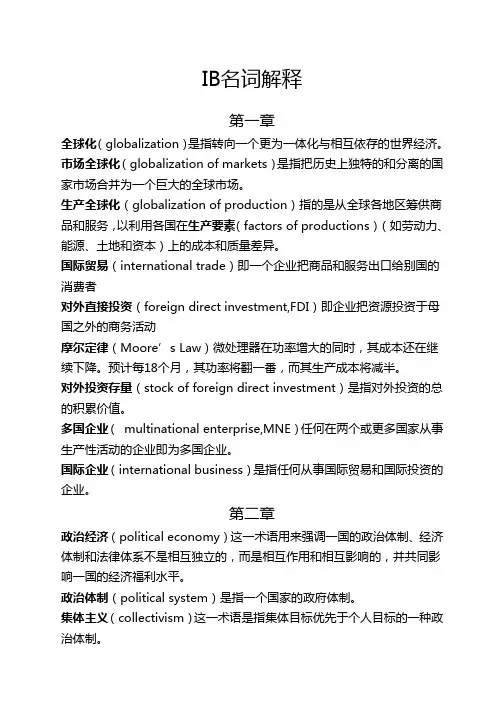
IB名词解释第一章全球化(globalization)是指转向一个更为一体化与相互依存的世界经济。
市场全球化(globalization of markets)是指把历史上独特的和分离的国家市场合并为一个巨大的全球市场。
生产全球化(globalization of production)指的是从全球各地区筹供商品和服务,以利用各国在生产要素(factors of productions)(如劳动力、能源、土地和资本)上的成本和质量差异。
国际贸易(international trade)即一个企业把商品和服务出口给别国的消费者对外直接投资(foreign direct investment,FDI)即企业把资源投资于母国之外的商务活动摩尔定律(Moore’s Law)微处理器在功率增大的同时,其成本还在继续下降。
预计每18个月,其功率将翻一番,而其生产成本将减半。
对外投资存量(stock of foreign direct investment)是指对外投资的总的积累价值。
多国企业(multinational enterprise,MNE)任何在两个或更多国家从事生产性活动的企业即为多国企业。
国际企业(international business)是指任何从事国际贸易和国际投资的企业。
第二章政治经济(political economy)这一术语用来强调一国的政治体制、经济体制和法律体系不是相互独立的,而是相互作用和相互影响的,并共同影响一国的经济福利水平。
政治体制(political system)是指一个国家的政府体制。
集体主义(collectivism)这一术语是指集体目标优先于个人目标的一种政治体制。
社会主义者(socialists)将马克思视为社会主义的思想源泉。
略共产主义者(communists)相信只有通过武装革命和专政,社会主义才能成功。
社会民主主义者(social democrats)则反对武装革命和专政,认为可以通过民主方式实现社会主义私有化(privatization)将国有企业出售给私人投资者个人主义(individualism)是指这样一种哲学,即一个人应享有其经济和政治追求的自由民主(democracy)是指这样一种政治制度,在该制度中,政府是由人民直接选举或通过其所选代表间接选举出来的。
cross cultural boundaries翻译
跨文化界限
一、定义
跨文化界限是指不同文化之间的分界线,就像不同国家之间建立边界是为了区分特定的文化。
跨文化界限是由特定的文化习俗、宗教信仰和语言所划分,它一般是
隐藏在人们看不见的、不能明显感受到的界限上。
二、形成
(1)政治原因
许多文化界限是由政治原因而产生的,例如,当国家建立边界时,就会产生一道文化界限。
三、影响
(1)降低文化融合度
跨文化界限会使得不同文化失去机会相互融合,并制造出更多的文化差异,进而
减少文化融合度。
四、突破
(1)了解文化差异
要想突破跨文化界限,首先需要了解不同的文化差异,帮助人们加深对另一种文化的了解,使得其能够更好地接受和理解另一种文化。
五、结论
跨文化界限是指不同文化之间的分界线,它是由多种因素造成的,包括政治原因、历史原因、民族因素、社会因素等等。
跨文化界限将会影响文化融合度,影响理解和影响彼此合作。
要想突破跨文化界限,需要了解不同的文化差异,建立有效沟通,提升交流能力,以期达到跨文化的理解与融合。
Thomas L.WarrenCross-Cultural Communication: Perspectives in Theory and PracticeBook Review—Reviewed byK EJUN X UIndex Terms—Audience analysis,cross-cultural communication,globalization.L arge companies like Microsoft,FedEx,Proctor&Gamble,and L’Oreal have long been doing business across borders,and a lot more small-and medium-sized enterprises are actively involved in the world marketplace.However,international business is no easy task,especially when it comes to communication across cultures.Accordingto the author Thomas L.Warren,transferring information across cultures has often presenteddifficult and complex communication problems.His book Cross-Cultural Communication:Perspectivesin Theory and Practice is oriented toward small-to medium-sized companies who cannot easily afford the expensive costs of translation services yet want to join in the worldwide market.It is a collection of essays focusing on communication-related cultural issues as well as on techniques and strategiesthat technical communicators can use to make their documents more acceptable in cross-cultural communication.In the introduction(Chapter1),Warrenfirst reviews the prohibitivefinancial cost of translation for small-and medium-sized companies as well asthe drawbacks to outsourcing translation work and then briefly analyzes various cultural issues hidden behind documents.He points out that his concern in these essays is not with translation, but rather“with the technical communicator who prepares documents in American English for users whosefirst language is not American English”[p. 2].Accordingly,he describes in detail both objective elements in culture—including rules,regulations, and points codified in various laws—and subjectiveManuscript received August10,2006;revised August20,2006. The reviewer is with the Technical Communication and Information Design Program,Illinois Institute of Technology, Chicago,IL60616USA(email:kxu5@).IEEE10.1109/TPC.2006.885878Book Publisher:Amityville,NY:Baywood,2005,138pp.,with index.elements,such as cultural-specific values,norms, beliefs,and attitudes that may affect cross-cultural communication.Further,he discusses several textual aspects involved in adapting a textto different cultures:semantics,metaphors, paragraph structures,syntax,context,reading habits,patterns of argumentation,and issues of old–new information as they apply in non-English languages and cultures.Overall,thefirst chapter serves as an introduction to cross-cultural communication and why cultural issues should be addressed in technical documentation.In the second chapter,“Issues in Internationaliza-tion of Technical Documentation:Quality Control,”Warren looks at matters relating to quality in documentation and cross-cultural communication. He argues that measures of quality in technical communication do not provide the whole picture unless they address cultural issues.Thus,he elaborates in detail on reader analysis,the goalof which is to use both objective and subjective cultural elements to adjust text and therefore to accommodate readers who are culturally different from the writer.Specifically,he outlines a table that identifies and contrasts12cultural factorsin two hypothetical cultures at the extremes. Though in reality the contrast may not be so sharp, those factors,including people’s perception of time,relations with the community,and so forth, are what writers should pay attention to when preparing any documentation that will be usedin different cultures.As a matter of fact,a key challenge facing technical communicators is how to match the cultural assumptions of the writer with those of the reader.In Chapter3,“National Cultures in International Communication,”Warren argues that three factors must be considered in order to manage meaning successfully in a document:language and culture, language and society,and restricted and elaborated language codes that different cultures possess.He0361-1434/$20.00©2006IEEEalso examines the concepts of senders,messages, receivers,and the third culture.Technical communicators(senders)adapt the informationin the message so that readers(receivers)can understand it.Therefore,the message represents a third culture that is neither totally the sender’s nor the receiver’s,but a combination or a new culture.In a word,the sender must carefully think about the language codes for both the contentand cultural implications he or she will use before preparing a document.To substantiate his theory, Warren cites a survey he conducted in Germany on ways of organizing a manual for a different culture.Three pools of respondents provided the elements that they thought should be applied to the document,among which categories as politics and religion were the most frequently mentioned ones. When it came to the specific organizational patterns of the document,answers were much more diverse due to the less controlled survey pools.Though the survey was informal,and no conclusive results can be obtained from it,it offers some insights into cross-cultural communication.Chapter4,“Communication Style Rules to Editors of International Standards,”is,in a sense,an extension and further elaboration of Chapter3. Warren reemphasizes the importance of authors’awareness of using specific language codes and metadiscourse for facilitating various information goals.After introducing the International Organization for Standardization Technical Committee(ISO TC)and a Quality Committee(QC) that controls the quality of the draft documents, he takes four sample documents produced by committees of the ISO and the International Electrotechnical Commission(IEC)and analyzes their language codes and metadiscourse, respectively.Surprisingly and disappointingly,the findings suggest that,by failing to meet proper language codes and metadiscourse requirements, those documents,though going by the name of “standardization,”are not stylistically appropriate. Warren’s questioning of“standards”reveals that there is still a lot to do in terms of international communication.Chapter5,“Cultural Influences on Technical Manuals,”is an application of theory to practice.Itfirst points out two of the most important cultural problems that concern communicators when they produce documents:languageand user expectations.To address those two problems,Warren analyzes what is typically used to understand another culture:attitude—in particular, toward knowledge,education,the product,and needs and goals.Then,two hypothetical cultures with extreme attitudes are presented,and Warren discusses the implications for style,content,and organization of technical manuals.With cultural elements borne in mind,technical documentswill be more accessible to readers from different cultures.Chapter6,“Increasing User Acceptance of Technical Information in Cross-Cultural Communication,”focuses on three aspects that technical communicators should pay attention to when they produce documents for users whosefirst language is not English:theories of communication, rhetoric,and culture.In regard to communication theory,Warren specifically addresses the compliance-gaining(C-G)theory that can change readers’behavior pliance,according to Warren,means“getting someone to do what you want them to do,”and by using several C-G strategies listed in a table,technical communicators could enhance the acceptance of their documents by users whosefirst language is not English[p.87]. Similarly,Warren describes rhetorical strategies and applies cultural analysis that may be used to produce user-friendly documents.The analyses of two hypothetical cultures of extreme attitude and a sample paragraph in the Microsoft Office2000 manual are also given to demonstrate how those strategies can be effective in a real communication process.This chapter is a further extension of how to apply theory into practice on the basis of Chapter 5and is also where readers of this book can get real hands-on instruction in how to facilitate cross-cultural communication.Chapter7,the conclusion,summarizessix strategies that could promote effective communication across cultures:audience analysis, cultural analysis,demographics,communication theory,rhetorical theory,and stylistic aids (metadiscourse).To conclude,Warren givesfive guidelines and recommendations for technical communicators who will write in English for receivers whosefirst language is not English:shift your perspective,view yourself as an intercultural communicator,develop an understanding of your own culture,be aware that the actual product or service that you are documenting can have cultural implications,and solicit a native speaker’s review of the document.The above guidelines,I believe,also apply to communicators whose documents will be translated into another language.My experience of doing written translation and interpretation of technicaldocuments and conferences also tells me how important it is to incorporate cultural elementsin the source language from the very beginning of document production.It is true that we can translate cultural elements to some degree; however,for translators and interpreters whoare not in the specified technicalfield—oftenthe case when the translation work is done by outsourcing—our primary responsibility is to guarantee the faithfulness and correctness ofthe translation into the target language from the source language.We would rather retain as much as possible in the original text,while daring not to infer too much that is not overtly indicated. Especially for interpreters whose work is highly instantaneous,applying cultural elements in interpretation is a greater challenge.Therefore,it is more of the technical communicator’s task to shoulder the responsibility of efficient and effective conveyance of information.On the whole,this book is an excellent read.Rather than presenting purely theoretical communication knowledge across cultures,it provides practical advice about cultural issues and problems.Vivid examples of how to apply his theory into practice and solutions to common challengesin thisfield shed light on conducting efficientand effective international communication. Certainly practitioners involved in cross-cultural communication will benefit from this book.In addition,instructors and students interested in thisfield can bridge different cultures using the strategies offered in the book.。